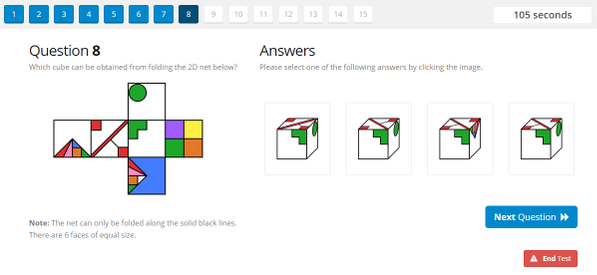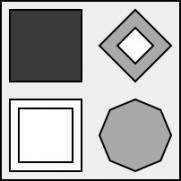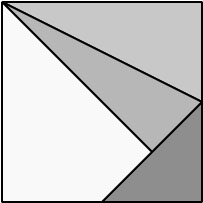Spatial Reasoning Practise Tests
Spatial Reasoning Trial
Try a FREE Spatial Reasoning test by clicking the button below.
Take a Free Test
Our carefully constructed spatial reasoning tests feature:
- Simple and affordable pricing, starting at 62¢ per test
- Try before you buy - no registration is required
- Easy to use online tests - available instantly after purchase
- Track your progress with your results area
What are Spatial Reasoning/Awareness tests?
Spatial Reasoning tests are designed to test your ability to mentally rotate and manipulate shapes in two or three dimensions
and are often used by recruiters of engineers, architects and many other professions to access candidates.
We have a variety of question types that you can practise with to help you improve this skill.
Try to visualise a room that you've recently been in.
How well you can remember what was in that room and how big it was? What size was the window?
What you'll be able to recall accurately is dependent on the level of spatial awareness you have.
Your estimations of measurements and distances can become more accurate as your spatial reasoning skills are practised.
Our tests have been designed to develop your spatial reasoning skills.
The tests are structured such that you can revisit past tests to see where you might have gone wrong, track your progress using our reporting system and much more.
Some of the typical questions candidates face in this test.
Below you will find a list of questions that feature in our tests.
Please note, this is not a comprehensive list of questions you may face in your tests.
Different organisations vary that type of questions that they use.
Folding and rotating 2-dimensional objects (nets) without aid
Example Question is displayed to the left.
This is one of the more tricky question types.
Here you are provided with a 2 dimensional net which you must fold into a cube (in your mind of course) and select the correct cube from the list of possible answers.
The nets can be given with any orientation forcing you to rotate as well as fold.
Want to take a go at this question?
Mirror images of varying difficulty
Example Mirror Image Question is displayed to the left.
Given an object that has many inner characteristics, select the mirror image of this object.
You will be given a variety of possible answers to chose from ensuring that the shapes and colours are in the correct mirrored positions.
The picture shown is one of our easiest mirror image questions.
Our tests go all the way up to have 16 inner shapes (whereas this one has four).
Found out how well you can answer the easy ones.
Rotating objects - eliminate impossible answers
Example 3D Object Rotation Question is displayed to the left.
Here you are given a cube and are required to identify which cube (from a possible 4 answers) represents the same original starting image but from a different angle.
This will test your ability to rotate 3D objects in your head under strict time conditions.
We have thousands of these they you can practise with.
Shape constructions and splits
Shape Construction question sample is displayed to the left.
You'll be given a number of pieces of a deconstructed shape, you must place them back together to form the original shape.
This tests your ability to concentrate on multiple objects at the same time.
See the example image to the left.
You'll be surprised how tricky some of these can be.
We've got some difficult ones at the end of our free trial test.
Arranging objects
Arrange question demo is displayed to the left.
This question type involves assembling the 4 shapes you are given into a cube, matching the colours/patterns.
You will be presented with 4 possible answers and you are required to identify the best match.
With enough practise, you'll be answer these questions in seconds.
How Spatial Reasoning Skills Propel Your Career
Unleashing Potential in Various Professions
Spatial reasoning isn't just about solving puzzles; it's a critical skill across numerous fields. Engineers, for instance, use it to envision complex components in machinery. Architects transform 2D blueprints into stunning 3D structures in their minds. Even fields like graphic design and surgery rely heavily on this ability to manipulate and visualize objects in space.
Real Success Stories
Hear from our users who've seen tangible career benefits after honing their spatial reasoning skills with our tests:
Engineer's Breakthrough: "Working in mechanical engineering demands a sharp ability to understand 3D spaces. Regular practice on this platform not only improved my day-to-day efficiency but also played a crucial role in my promotion to a senior engineering role."
Spatial Reasoning FAQ
Q.I have a test coming up, should I practise?
Our Answer:
Spatial reasoning or spatial awareness can be developed like any skill.
By practising you can become more in-tune with the requirements of these tests and give yourself the best chance possible of passing.
Like any skill, the more it is practised the better it will become at it.
Q.Where are these tests used?
Our Answer:
The majority of employers now use aptitude tests as part of the recruitment process to ensure the suitability of possible employees to the role they are applying for.
Many of these aptitude tests will involve a special reasoning section.
Companies that recruit engineers, architects, air traffic controllers are most likely to use these in their candidate selection tests.
Q.Why should I use your tests to practise my spatial reasoning?
Our Answer:
Our users have access to one of the most unique systems for spatial reasoning tests.
While some sites have prepared questions that are the same for all users, our tests are user unique in that each test is randomly generated from our vast bank of patterns.
This means that users have access to a huge number of tests and can practise using a different set of patterns each time, rather than repeating the same questions over and over again.









